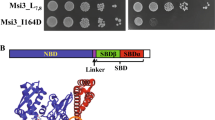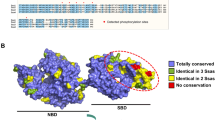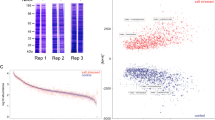Abstract
It was previously shown that the presence of estrogen enhances survival of Candida albicans under heat and oxidative stresses. A 92-kDa protein is inducible by heat shock and estrogen in C. albicans. Previous studies have described this protein as hsp90 because of its molecular size and heat inducibility as seen on electrophoretic gels and Western blots. In this study, ion exchange, hydroxy apatite and size exclusion chromatography were used to isolate a 92-kDa-protein band. The N-terminal sequence of isolated protein blotted onto a PVDF membrane was determined to be V-Q-S-?-V-L-G-F-P-R. This sequence is homologous to the N-terminal sequence of the MET6 gene product, cobalamin-independent methionine synthase, from Saccharomyces cerevisiae. The results of this study suggest that a cobalamin-independent methionine synthase homolog is inducible by heat and estrogen in C. albicans. This study also suggests that Candida hsp90 is more likely to exist as an 82-kDa protein as predicted by a previously described cDNA and not as a 92-kDa protein as reported in the literature.
Similar content being viewed by others
References
Odds FC. Candida Species and Virulence. ASM News 1994; 60(6): 313–318.
Cutler J. Putative Virulence factors of Candida albicans. Annu. Rev. Microbiol. 1991; 45: 187–218.
White S, Larsen B. Candida albicans morphogenesis is influenced by estrogen. Cell Mol Life Sci 1997; 53(9): 744–749.
Gow NAR. Growth and Guidance of the Fungal Hypha. Microbiology 1994; 140: 3193.
Shah DT, Glover DD, Larsen B. In situ mycotoxin production by Candida albicans in women with vaginitis. Gynecol Obstet Invest 1995; 39(1): 67–69.
Gujjar PR, Finucane M, Larsen B. The effect of estradiol on Candida albicans growth. Ann Clin Lab Sci 1997; 27(2): 151–156.
O'Connor C, Essmann M, Larsen B. 17-beta-estradiol upregulates the stress response in Candida albicans: implications for microbial virulence. Infect Dis Obstet Gynecol 1998; 6(4): 176–181.
Mager WH, Ferreira PM. Stress response of yeast. Biochem J 1993; 290(Pt 1): 1–13.
Louvion JF, Abbas-Terki T, Picard D. Hsp90 Is Required for Pheromone Signaling in Yeast. Mol Biol Cell 1998; 9(11): 3071–3083.
Pratt WB. The role of the hsp90-based chaperone system in signal transduction by nuclear receptors and receptor signaling via MAP kinase. Annual Review of Pharmacology and Toxicology 1997; 37: 297–326.
Stancato LF, Silverstein AM, OwensGrillo JK, Chow YH, Jove R, Pratt WB. The hsp90-binding antibiotic geldanamycin decreases Raf levels and epidermal growth factor signaling without disrupting formation of signaling complexes or reducing the specific enzymatic activity of raf kinase. Journal of Biological Chemistry 1997; 272 (7): 4013–4020.
Nathan DF, Vos MH, Lindquist S. In vivo functions of the Saccharomyces cerevisiae Hsp90 chaperone. Proceedings of the National Academy of Sciences of the United States of America 1997; 94 (24): 12949–12956.
Swoboda RK, Bertram G, Budge S, Gooday GW, Gow NA, Brown AJ. Structure and regulation of the HSP90 gene from the pathogenic fungus Candida albicans [published erratum appears in Infect Immun 1996 Feb; 64(2): 680]. Infect Immun 1995; 63(11): 4506–4514.
Hodgetts S, Matthews R, Morrissey G, Mitsutake K, Piper P, Burnie J. Over-expression of Saccharomyces cerevisiae hsp90 enhances the virulence of this yeast in mice. FEMS Immunol Med Microbiol 1996; 16: 229–234.
Matthews R, Burnie J. The role of hsp90 in fungal infection. Immunol Today 1992; 13(9): 345–348.
Matthews RC, Burnie JP, Tabaqchali S. Isolation of immunodominant antigens from sera of patients with systemic candidiasis and characterization of serological response to Candida albicans. J Clin Microbiol 1987; 25(2): 230–237.
Matthews R, Burnie J. Cloning of a DNA sequence encoding a major fragment of the 47 kilodalton stress protein homologue of Candida albicans. FEMS Microbiol Lett 1989; 51(1): 25–30.
Matthews RC. HSP90, yeasts and Corynebacterium jeikeium. Epidemiol. Infect. 1991; 107: 273–283.
Srivastava PK. Purification of heat shock protein - Peptide complexes for use in vaccination against cancers and intracellular pathogens. Methods a Companion to Methods in Enzymology 1997; 12(2): 165–171.
Laemmli UK. Cleavage of structural proteins during the assembly of the head of bacteriophage T4. Nature 1970; 227: 680–685.
Cleveland DW, Fischer SG, Kirschner MW, Laemmli UK. Peptide mapping by limited proteolysis in sodium dodecyl sulfate and analysis by gel electrophoresis. J Biol Chem 1977; 252(3): 1102–1106.
Towbin H, Staehelin T, Gordon J. Electrophoretic transfer of proteins from polyacrylamide gels to nitrocellulose sheets: procedure and some applications. Proc Natl Acad Sci USA 1979; 76(9): 4350–4354.
Burnette WN. “Western blotting”: electrophoretic transfer of proteins from sodium dodecyl sulfate-polyacrylamide gels to unmodified nitrocellulose and radiographic detection with antibody and radioiodinated protein A. Anal Biochem 1981; 112(2): 195–203.
Strickler JE, Hunkapiller MW, Wilson KJ. Utility of the gasphase sequencer for both liquid-and solid-phase degradation of proteins and peptides at low picomole levels. Anal Biochem 1984; 140(2): 553–566.
Niall HD. Automated Edman degradation: the protein sequenator. Methods Enzymol 1973; 27: 942–1010.
Boucherie H, Dujardin G, Kermorgant M, Monribot C, Slonimski P, Perrot M. Two-dimensional protein map of Saccharomyces cerevisiae: construction of a gene-protein index. Yeast 1995; 11(7): 601–613.
Farrelly FW, Finkelstein DB. Complete sequence of the heat shock-inducible HSP90 gene of Saccharomyces cerevisiae. J Biol Chem 1984; 259(9): 5745–5751.
Zeuthen ML, Howard DH. Thermotolerance and the heatshock response in Candida albicans. J Gen Microbiol 1989; 135(Pt 9): 2509–2518.
Gething MJ, Sambrook J. Protein folding in the cell. Nature 1992; 355: 33–45.
Lindquist S, Craig EA. The heat-shock proteins. Annu Rev Genet 1988; 22: 631–677.
Balish E. Methionine biosynthesis and S-adenosylmethionine degradation during an induced morphogenesis of Candida albicans. Can J Microbiol 1973; 19(7): 847–853.
Godon C, Lagniel G, Lee J, Buhler JM, Kieffer S, Perrot M, et al. The H2O2 stimulon in Saccharomyces cerevisiae. J Biol Chem 1998; 273(34): 22480–22489.
Csermely P, Schnaider T, Soti C, Prohaszka Z, Nardai G. The 90-kDa molecular chaperone family: structure, function, and clinical applications. A comprehensive review. Pharmacol Ther 1998; 79(2): 129–168.
Szyszka R, Kramer G, Hardesty B. The phosphorylation state of the reticulocyte 90-kDa heat shock protein affects its ability 20 to increase phosphorylation of peptide initiation factor 2 alpha subunit by the heme-sensitive kinase. Biochemistry 1989; 28(4): 1435–1438.
Palmquist K, Riis B, Nilsson A, Nygard O. Interaction of the calcium and calmodulin regulated eEF-2 kinase with heat shock protein 90. FEBS Lett 1994;3 49(2): 239–242.
Author information
Authors and Affiliations
Rights and permissions
About this article
Cite this article
Burt, E.T., O'Connor, C. & Larsen, B. Isolation and identification of a 92-kDa stress induced protein from Candida albicans . Mycopathologia 147, 13–20 (1999). https://doi.org/10.1023/A:1007036518330
Issue Date:
DOI: https://doi.org/10.1023/A:1007036518330




